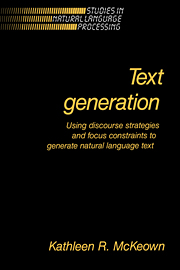Book contents
- Frontmatter
- Contents
- Preface
- 1 Introduction
- 2 Discourse Structure
- 3 Focusing in discourse
- 4 TEXT system implementation
- 5 Discourse history
- 6 Related generation research
- 7 Summary and conclusions
- Appendix A Sample output of the TEXT system
- Appendix B Introduction to Working
- Appendix C Resources used
- Appendix D Predicate Semantics
- Bibliography
- Index
7 - Summary and conclusions
Published online by Cambridge University Press: 23 December 2009
- Frontmatter
- Contents
- Preface
- 1 Introduction
- 2 Discourse Structure
- 3 Focusing in discourse
- 4 TEXT system implementation
- 5 Discourse history
- 6 Related generation research
- 7 Summary and conclusions
- Appendix A Sample output of the TEXT system
- Appendix B Introduction to Working
- Appendix C Resources used
- Appendix D Predicate Semantics
- Bibliography
- Index
Summary
In this research, I have shown how principles of discourse structure, discourse coherency, and relevancy criterion can be used for the task of generating natural language text. Each of these areas is particularly important since the generation of text and not simply the generation of single sentences was studied. In this section, the principles and their incorporation as part of the text generation method are reviewed. Some limitations of the generation method are then discussed and finally, some possibilities for future research are presented.
Discourse structure
A central thesis of this research is based on the observation that descriptions of the same information may vary from one telling to the next. This indicates that information need not be described in the same way in which it is stored. For the generation process, this means that production of text does not simply trace the knowledge representation. Instead, standard principles for communication are used to organize a text. These rhetorical techniques are used to guide the generation process in the TEXT system. Since different rhetorical techniques are associated with different discourse purposes, it was shown that different descriptions of the same information can be produced depending upon the discourse situation. By incorporating commonly used techniques for communication into its answers, the system is able to convey information more effectively.
Relevancy criterion
It was pointed out that, when speaking, people are able to ignore large bodies of knowledge and focus on information that is relevant to the current discourse purpose. By constraining focus of attention to relevant information, a generation system is able to determine more efficiently what should be said next.
- Type
- Chapter
- Information
- Text Generation , pp. 195 - 204Publisher: Cambridge University PressPrint publication year: 1985

